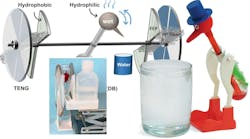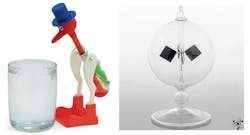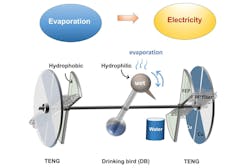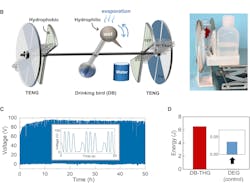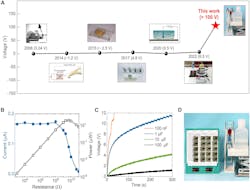“Drinking Bird” Becomes an Evaporation-Driven Triboelectricity Energy Harvester
What you’ll learn:
- How a “drinking bird” engine converts evaporation energy into kinetic motion.
- How to use a triboelectric nanogenerator to convert kinetic motion into electricity.
- How to generate over 100 V through natural water evaporation.
I‘ll be honest, when I first came across this research paper from the teaming of two Hong Kong universities and a university from China, I thought it was either a joke or the work of a clever middle-school student, rather than a serious project.
But on closer examination, I realized I was wrong. Inspired by the classic “drinking bird” toy, researchers developed an energy-harvesting approach that converts energy from water evaporation into electricity to power small electronics with relative efficiency.
Drinking Bird Energy Conversion: Not as Simple as It Seems
The device produces energy outputs exceeding 100 V—much higher than other techniques that generate electricity from water—and can operate for several days using only 100 ml of water as fuel. The drinking bird toy can continuously collect this evaporation energy and convert it into low-frequency kinetic energy in the form of a swinging motion.
Also called a "dippy bird," the toy has been a fixture of science classrooms for decades (Fig. 1).1 Its action is highly simple enough and visible, captivating, and even fascinating (and where are its batteries, anyway?), but the underlying physics principles that it embodies aren’t simple.
In this respect, it’s similar to another basic classroom demonstrator, the well-known Crookes radiometer.2 (Note: This isn’t the first drinking bird energy harvester, but the researchers claim their triboelectric-based approach offers much-higher output power and efficiency than other units that use electromagnetic-based harvesting.)
If you’re not familiar with this bird, it consists of two glass bulbs connected by a glass tube partially filled with methylene chloride, a highly volatile liquid. The top bulb, which includes the bird's beak and a decorative top hat, is covered in a felt-like material, and the bird's body is suspended on two plastic legs. After the bird's head is dipped in a glass of water, the water begins to evaporate.
This results in a pressure difference that causes the fluid in the bottom bulb to rise through the tube until it fills the head. It causes the bird to dip forward into the water to "take a drink" before the process starts again.
Capturing the apparently “free” motion of the drinking bird to harvest energy is a challenge. The operating mechanism has relatively low torque—even a little additional friction in the arrangement can cause the bird’s motion to “lock up,” thus negating the opportunity to harvest energy.
How Does the Drinking Bird Setup Work?
The triboelectric nanogenerator (TENG) converts the low-frequency and random mechanical motions of water into electricity by taking advantage of hydrophobic materials with high surface charge density (Fig. 2).
To overcome the friction caused by tribo-materials in conventional TENGs, which restricts the movement of the drinking bird, improvements were made to the TENG device. For example, to enhance the energy-conversion efficiency from the low-frequency swing motion generated by the drinking bird engine, they designed a TENG featuring patterned soft polypropylene (PP) cotton.
This greatly reduces the friction loss between the tribo-materials, enabling the continual energy harvesting from the small mechanical energy induced by the evaporation. By using patterned PP cotton as tribo-materials, they enabled the device to operate in a soft-contact mode with intermittent intervals.
Each TENG’s rotor, equipped with a fluorinated ethylene propylene (FEP) film, remains approximately 1 cm away from the stator to ensure minimal friction throughout the swinging process. As the rotor swings, the charged FEP film induces a transfer of counter-charges between the two copper-film electrodes on the stator, creating an electric current flow to power the load.
In addition, during the dipping stage, the FEP films connect with the patterned PP cotton located at the edge of those electrodes. This facilitates the accumulation of negative charges onto the FEP film due to the triboelectrification effect (Fig. 3).
The existing drinking-bird-based electromagnetic electricity generation technique suffers from low power output due to its low-frequency and weak kinetic motions. This is evidenced by the previous experimental result that only 0.04 V of peak voltage and ∼3 μW of peak power were generated by leveraging the conventional generator.
Results Obtained from Drinking Bird Hydrovoltaic Generator
In contrast, their DB-THG achieved impressive outputs, with maximum voltage, current, and charge reaching 107 V, 0.24 μA, and 40 nC, respectively (at 24°C, ∼28% RH) (Fig. 4).
These values far surpass those previously reported for water evaporation power. The voltage, charge, and current output of the drinking bird triboelectric hydrovoltaic generator (DB-THG) were measured by using a programmable electrometer and a commercial temperature-controlled humidity chamber.
Moreover, they maintain that their DB-THG not only excels in voltage generation, but also delivers impressive power output. In an environment with a temperature of 25°C and a RH of ∼20%, it generates a maximum peak power of ∼40 μW. This power output is 13X higher than that obtained using a drinking bird engine and an electromagnetic generator in previous experiments.
The high output of their DB-THG enabled the team to effectively power small electronics using the natural energy from water evaporation in any ambient environment. They demonstrated that 20 liquid crystal displays (LCDs), sized at 26 × 31 mm, can directly be powered by the DB-THG. Furthermore, the electricity generated by the DB-THG can be efficiently stored in commercial capacitors, charging them to above 10 V within several minutes and a relatively larger capacitor of 1,000 μF is also charged to 1.5 V in 100 minutes.
The work is detailed in their paper “Drinking-bird-enabled triboelectric hydrovoltaic generator” published in Cell Press. This topic naturally lends itself to videos, and the posted paper has links to a several interesting ones. Also of note: The authors don’t imply that this harvesting arrangement is the solution to the world’s energy problems, which many other harvesting projects imply despite their low energy intensity and density.
References
1. University of California/Riverside, “What is a Dippy Bird, and how is it used?”
2. Stanford University, “The Force Driving the Crookes Radiometer.”
